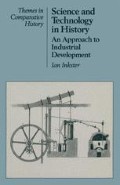Abstract
AT a meeting of the Glasgow branch of the British Society of Chemical Industry in November 1885, its chairman, J. Neilson Cuthbertson, offered yet one more comment by British industry upon recent European and American innovation in the organisation of science. Cuthbertson noted the splendid provision for science and engineering at the newly erected University of Strasburg, its 92 professors and large laboratory facilities. His measure of scientific improvement was manifold and included its contribution to industry, its institutional formalisation, its support by and of the State:
I might refer to the great success that has attended Continental science in different ways; in organic chemistry, in the introduction of the ammonia process in the alkali trade, in the ventilation of deep mines, in the application of water power, in the invention of the dynamo machine, in the construction of roofs and bridges, in the printed cottons of Mulhouse, in the woolen yarns of Verviers and in the ribbon trade of Basle … all the principal machinery that is now at work on the Continent has been derived from England, or, at all events, is the direct offspring of suggestions made in Great Britain … the beginnings of the modern industrial systems are due in the main to Great Britain.… This was no doubt the occasion of the great efforts put forth by Continental nations to cope with this country, and they began by instituting Polytechnic Schools.
the sole aim of our thoughts and our exertions must be the kind of organisation most favourable to industry … including every kind of useful activity, theoretical as well as practical, intellectual as well as manual
Saint Simon, 1817
Man has mounted science and is now run away with
Henry Adams, 1862
Preview
Unable to display preview. Download preview PDF.
Notes
Thomson’s lab. was first established in 1850, but only officially recognised sixteen years later. This should not be confused with Thomas Thomson’s Chemical Laboratory at Glasgow after 1829, the year in which chemical laboratory work began also at University College, London. The second wave of university laboratories, from around 1878 to 1900, were associated with the academic rise of engineering and electrical engineering. See W. H. Armytage, A Social History of Engineering (New York, 1961); C. Domb (ed.), Clerk Maxwell and Modern Science (London, 1963); R. Sviedrys, ‘The Rise of Physics Laboratories in Britain’, Historical Studies in the Physical Sciences, 7 (1976), pp. 405–35.
For change and resistance to change at Oxbridge see Roy MacLeod and Russell Moseley, ‘Breadth, Depth and Excellence: Sources and Problems in the History of University Science Education in England, 1850–1914’, Studies in Science Education, 5 (1978), pp. 85–106
F. S. Taylor, ‘The Teaching of Science at Oxford in the Nineteenth Century’, Annals of Science, 8 (1952), pp. 82–112
Jack Morrell, ‘Science and the Universities’, History of Science, 15 (1977), pp. 145–52
R. Sviedrys, ‘The Rise of Physical Science at Victorian Cambridge’, Historical Studies in the Physical Sciences, 2 (1970), pp. 127–38
David B. Wilson, ‘Experimentalists Among the Mathematicians: Physics in the Cambridge Natural Science Tripos 1851–1900’, H.S.P.S., 12 (1981), pp. 325–43.
Joseph Ben-David, ‘The Rise and Decline of France as a Scientific Centre’, Minerva, 8 (1970), pp. 160–79
the commentary on the above by T. N. Clark, Minerva, 8 (1970), pp. 599–601
H. W. Paul, ‘The Issue of Decline in Nineteenth-Century French Science’, French Historical Studies, 7 (1972), pp. 416–50
Peter Lundgreen, ‘Educational Expansion and Economic Growth in Nineteenth Century Germany: A Quantitative Study’, in L. Stone (ed.), Schooling and Society, Studies in the History of Education (Baltimore, 1976); ‘German Technical Associations Between Science, Industry and the State 1860–1914’, Historical Social Research, 13 (1980), pp. 30–15
Lewis T. Wright, ‘Opening Address to Nottingham Branch’, 23 November 1887; Journal of the Society of Chemical Industry, 7 (1888), p. 27.
Shadwell, op. cit. (n. 24), p. 429, 431. For the view of economists at this time see E. W. Evans and N. C. Wiseman, ‘Education, Training and Economic Performance: British Economists’ Views 1868–1939’, Journal of European Economic History, 13 (1984), pp. 129–148.
J. M. Stopford, ‘The Origins of British-based Multinational Manufacturing Enterprises’, Business History Review, 48 (1974), pp. 303–34.
These figures are from Rose, op. cit. (n. 30) and F. M. Perkin, ‘Chemical Instruction and Chemical Industries in Germany’, Nature, 65 (1901), pp. 174–6.
J. B. Poole and Kay Andrews (eds), The Government of Science in Britain (London, 1972); A.J. Taylor, Laissez-faire and State Intervention in 19thc Britain (London, 1972); Oliver MacDonagh, ‘The Nineteenth Century Revolution in Government: A Reappraisal’, Historical Journal I (1958), pp. 52–67.
Roy M. MacLeod, ‘Statesmen Undisguised’, American Historical Review, 78 (1973), pp. 386–405.
Roy M. MacLeod, ‘The Royal Society and the Government Grant: Notes on the Administration of Scientific Research 1849–1914’, Historical Journal, 14 (1971), pp. 323–58
F. A. Bather, ‘Natural Science in Japan’, Natural Science, IV, January 1894, p. 190.
Reprinted in A. T. Simmons, ‘Education and Progress in Japan’, Nature, 69, 3 March 1904, pp. 416–18.
D. McCloskey (ed.), Essays in a Mature Economy (Cambridge, Mass., 1970); S. Nicholas, ‘Total Factor Productivity Growth and the Revision of Post-1870 British Economic History’, Econ. Hist. Review, 35 (1982), pp. 83–97
Copyright information
© 1991 Ian Inkster
About this chapter
Cite this chapter
Inkster, I. (1991). The Scientific Enterprise: Institutions and the Diffusion of Knowledge in the Nineteenth Century. In: Science and Technology in History. Themes in Comparative History. Palgrave, London. https://doi.org/10.1007/978-1-349-21339-9_4
Download citation
DOI: https://doi.org/10.1007/978-1-349-21339-9_4
Publisher Name: Palgrave, London
Print ISBN: 978-0-333-42858-0
Online ISBN: 978-1-349-21339-9
eBook Packages: Palgrave History CollectionHistory (R0)

